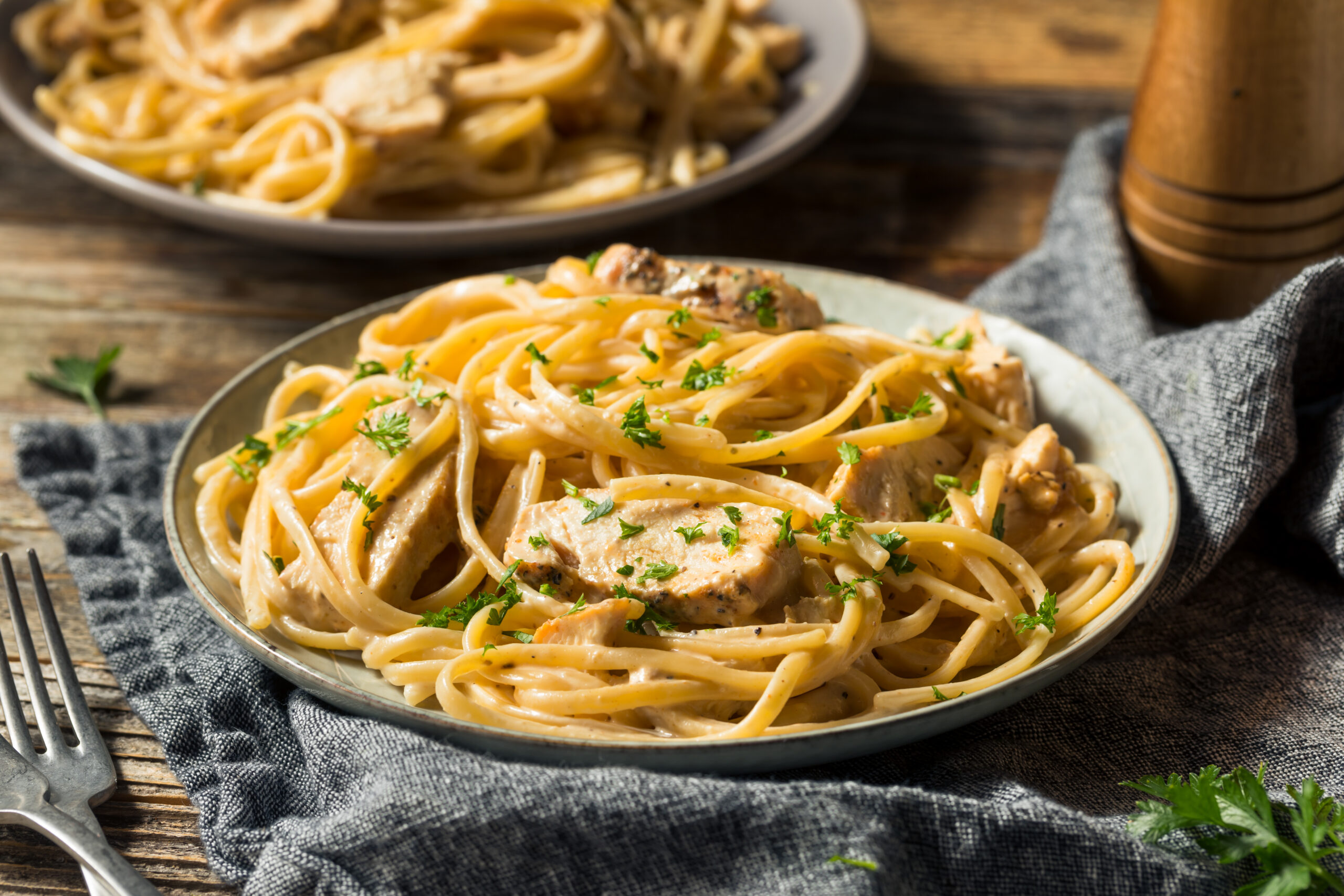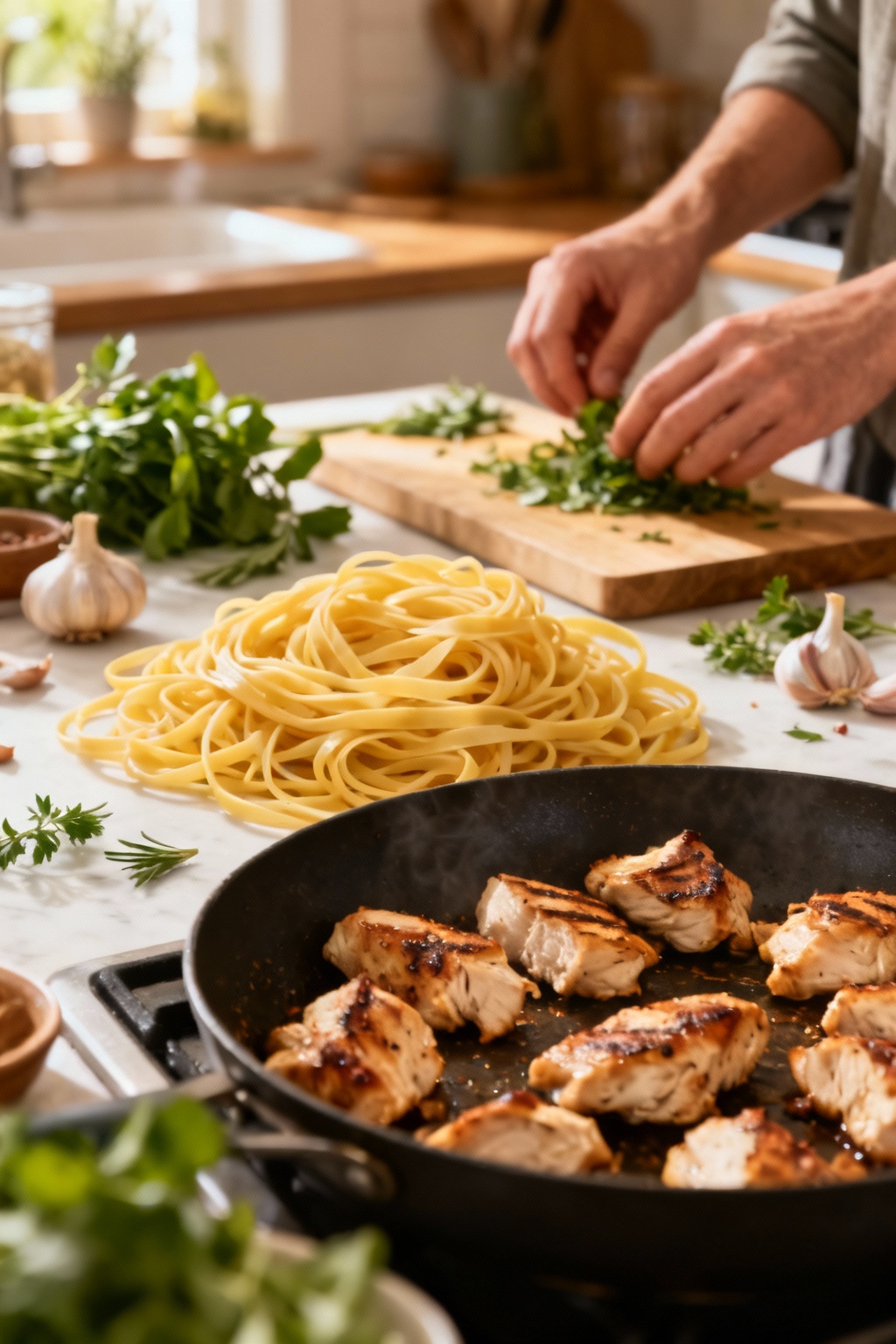Physical Address
304 North Cardinal St.
Dorchester Center, MA 02124
Physical Address
304 North Cardinal St.
Dorchester Center, MA 02124

Let me tell you about the time I discovered Cowboy Butter Chicken Linguine and accidentally turned my weeknight dinner routine upside down. This isn’t just another pasta recipe – it’s that rare unicorn dish that makes people think you spent hours in the kitchen when really you were just tossing things in a pan while watching TikTok videos about… more pasta recipes.
!
What makes Cowboy Butter Chicken Linguine so special is the magical compound butter that transforms ordinary pasta into something you’d happily pay $24 for at a restaurant. It’s creamy without heavy cream, rich without being overwhelming, and has this perfect balance of garlic, herbs, and subtle heat that makes your taste buds do a little happy dance.
Plus, unlike most “fancy” pasta dishes, this one doesn’t require a culinary degree or seventeen specialty ingredients you’ll use once and then forget about until they eventually evolve into new life forms in the back of your pantry.
For the Cowboy Butter:
For Everything Else:
Prep the star player – Make your cowboy butter by combining room temperature butter with garlic, herbs, lemon zest, red pepper flakes, salt and pepper. Mix until everything is evenly distributed. This is the heart and soul of your Cowboy Butter Chicken Linguine, so give it the respect it deserves.
Boil your pasta – Bring a large pot of heavily salted water to a boil and cook linguine until just shy of al dente (about 1-2 minutes less than package directions). Reserve at least ½ cup of pasta water before draining!
Cook the chicken – While the pasta boils, season chicken pieces with salt and pepper. Heat a large skillet over medium-high heat, add a tablespoon of olive oil, and cook chicken until golden and cooked through, about 5-7 minutes.
Make it saucy – If using wine, pour it into the hot pan with the chicken and let it bubble for a minute to burn off the alcohol. Lower heat to medium-low.
Bring it all together – Add the drained pasta to the skillet with the chicken. Drop in the cowboy butter in pieces and toss gently. Gradually add the reserved pasta water, a couple tablespoons at a time, while continuously tossing until a silky sauce forms. This is where patience pays off!
Melting the butter first – This isn’t regular butter pasta. The room temperature compound butter needs to slowly melt into the hot pasta to create that perfect emulsion. Melt it first and you’ll just have an oily mess that makes you question your life choices.
Skipping the pasta water – That starchy liquid is basically culinary glue. Without it, your sauce will never come together, and your Instagram story will be sadly lacking in those sexy pasta-toss videos.
Overcooking the chicken – Those little pieces cook fast! Overdo it and you’ll be serving chicken erasers instead of tender morsels of joy.
Rushing the sauce – There’s a magical moment where the sauce looks broken and sad, and then suddenly transforms into silky perfection. Don’t panic and give up right before the miracle happens.
Not into chicken? Shrimp works beautifully here and cooks even faster. Vegetarian? Throw in some sautéed mushrooms and a handful of peas for a meaty texture without the actual meat.
Fresh herbs are ideal, but if your herb garden is currently a sad graveyard of brown stems (I see you), use 1 tablespoon dried parsley and 2 teaspoons dried chives instead. Just don’t tell any Italians I said that.
Pasta shapes: While Cowboy Butter Chicken Linguine traditionally uses, well, linguine, any long pasta works. Bucatini actually holds the sauce better with its hollow center, and fettuccine brings extra surface area to the butter party.
Can I make Cowboy Butter Chicken Linguine ahead of time?
The cowboy butter itself can be made ahead and refrigerated, but the final dish is best fresh. If you must reheat leftovers, add a splash of chicken broth and warm gently.
Is this spicy?
It has a gentle kick from the red pepper flakes. If you’re spice-averse, start with ¼ teaspoon. If you’re the type who carries hot sauce in your purse, double it.
Can I use chicken breasts instead of thighs?
Yes, but they cook faster and are easier to dry out. If using breasts, cook them just until they reach 160°F and let carryover cooking finish the job.
What can I serve with Cowboy Butter Chicken Linguine?
A simple green salad and garlic bread are perfect companions. Or just a larger portion of pasta. I don’t judge.
How did cowboy butter get its name?
Legend has it that this flavorful compound butter was popular in Western ranch cooking, where cowboys would slather it on grilled meats. The pasta application is newer but infinitely more exciting.
Can I freeze leftovers?
Technically yes, practically no. The sauce will separate when thawed and reheated. But if you’ve actually managed to have leftovers of this dish, I’m impressed by your self-control.
Once you’ve mastered this Cowboy Butter Chicken Linguine, you’ll find yourself craving it regularly and impressing dinner guests with minimal effort. The technique of creating an emulsion with pasta water and compound butter is one that will serve you well across many pasta recipes in your cooking future.
If you’re looking for more pasta inspiration, check out these easy dinner recipes that follow similar principles. And for a deeper dive into why pasta water is basically liquid gold, this Serious Eats article on pasta cooking techniques will change how you approach every pasta dish going forward.
Now go forth and butter up your pasta game – your dinner table (and Instagram feed) will thank you.
Want just the essential recipe details without scrolling through the article? Get our printable recipe card with just the ingredients and instructions.